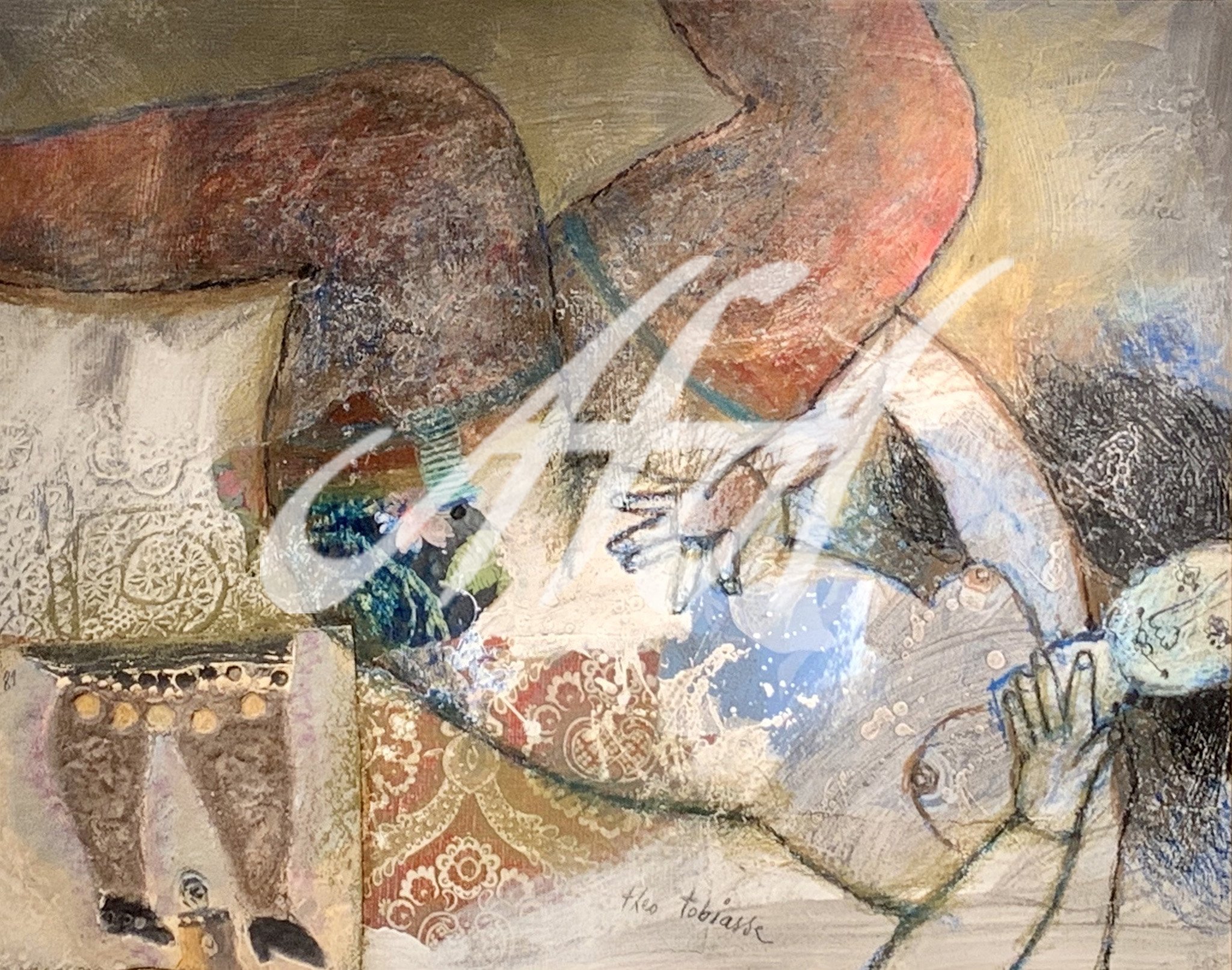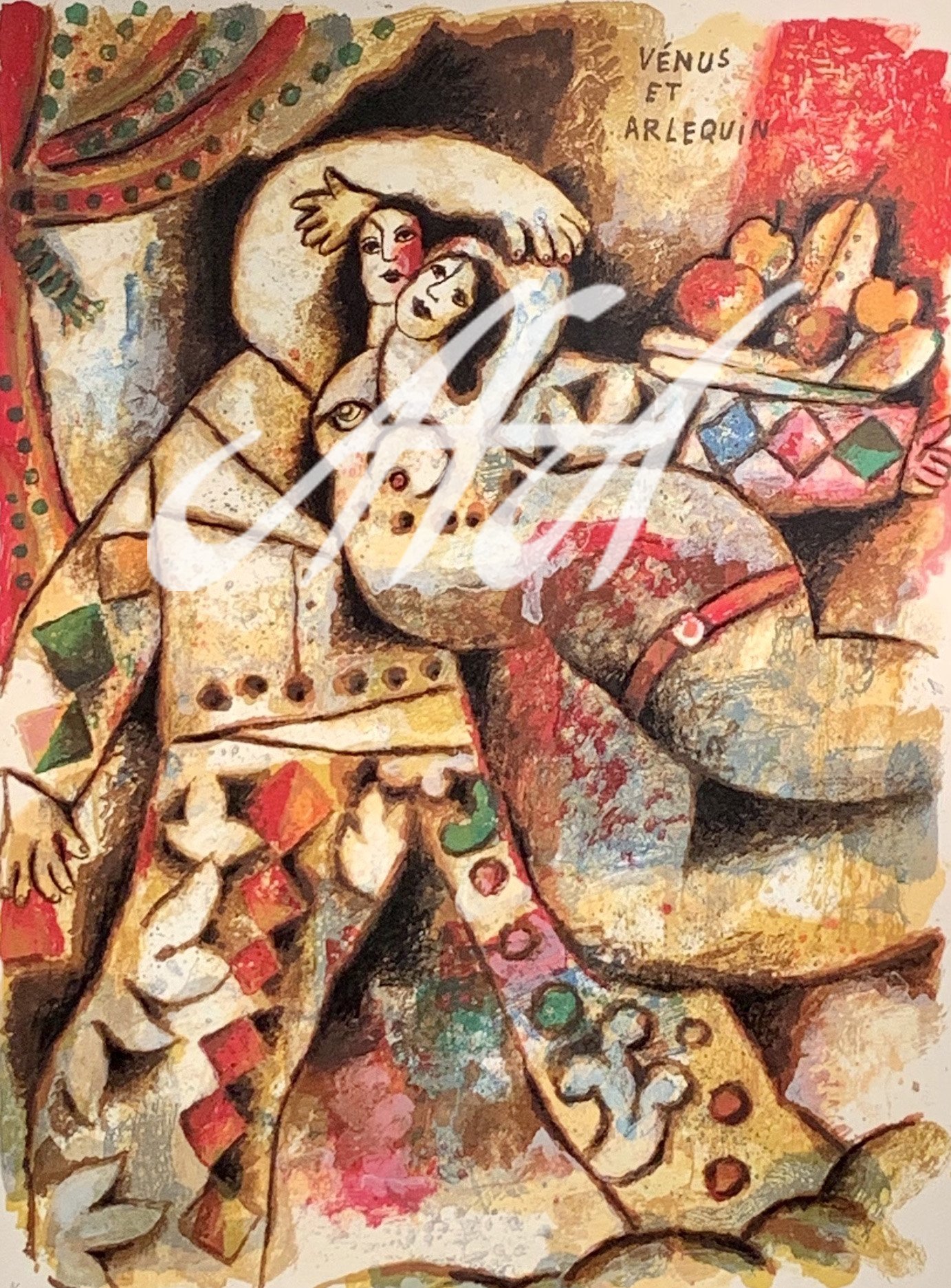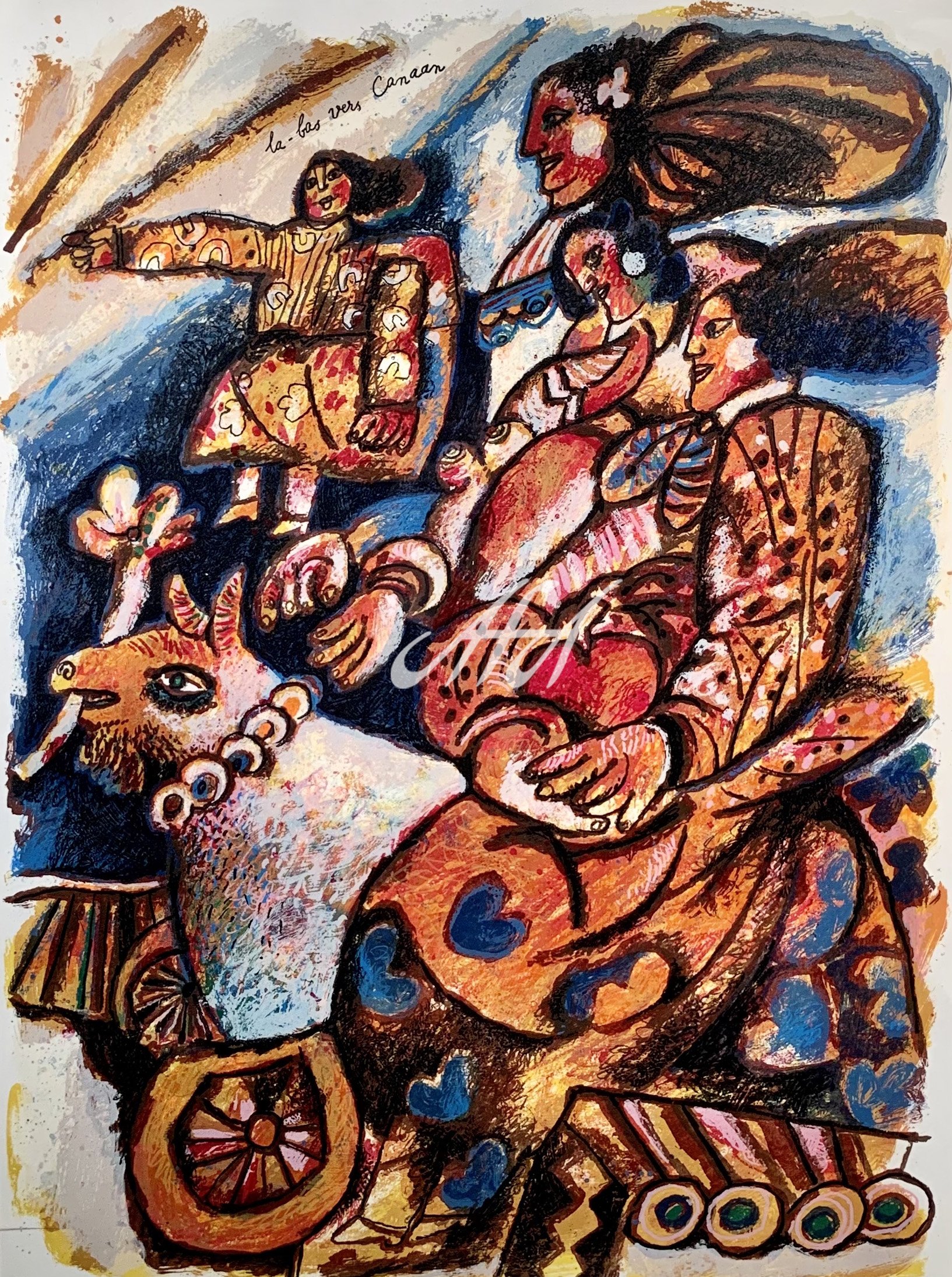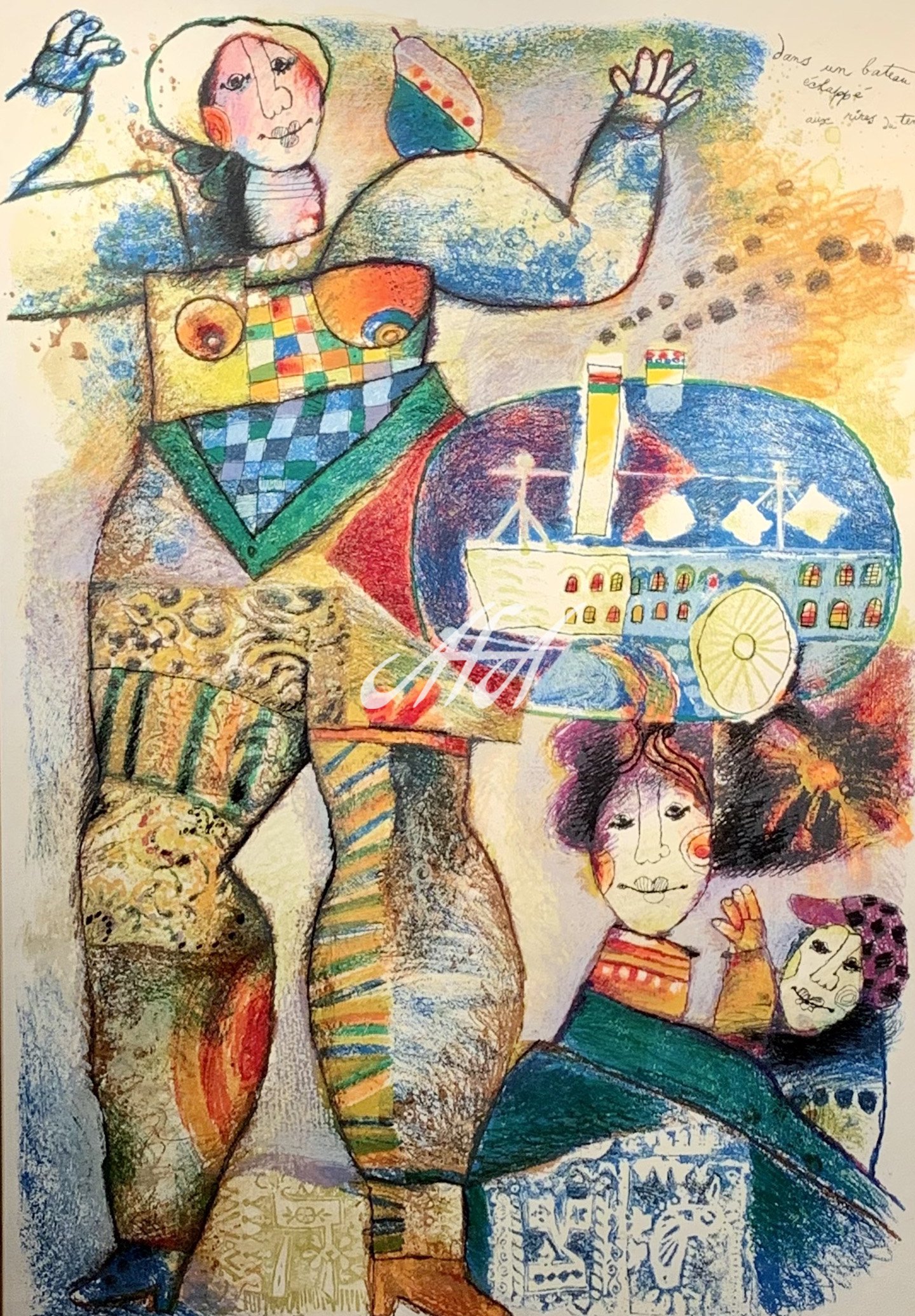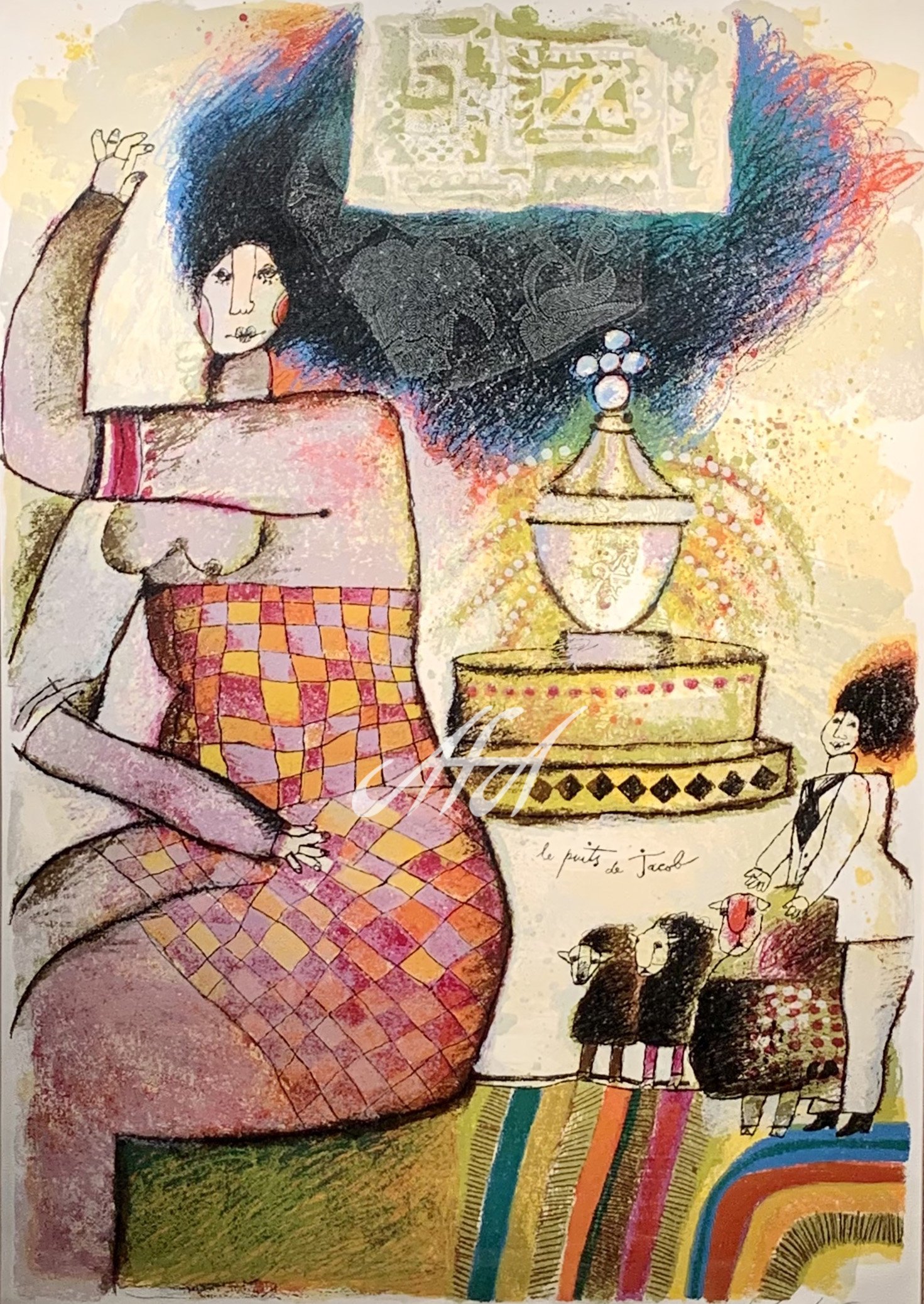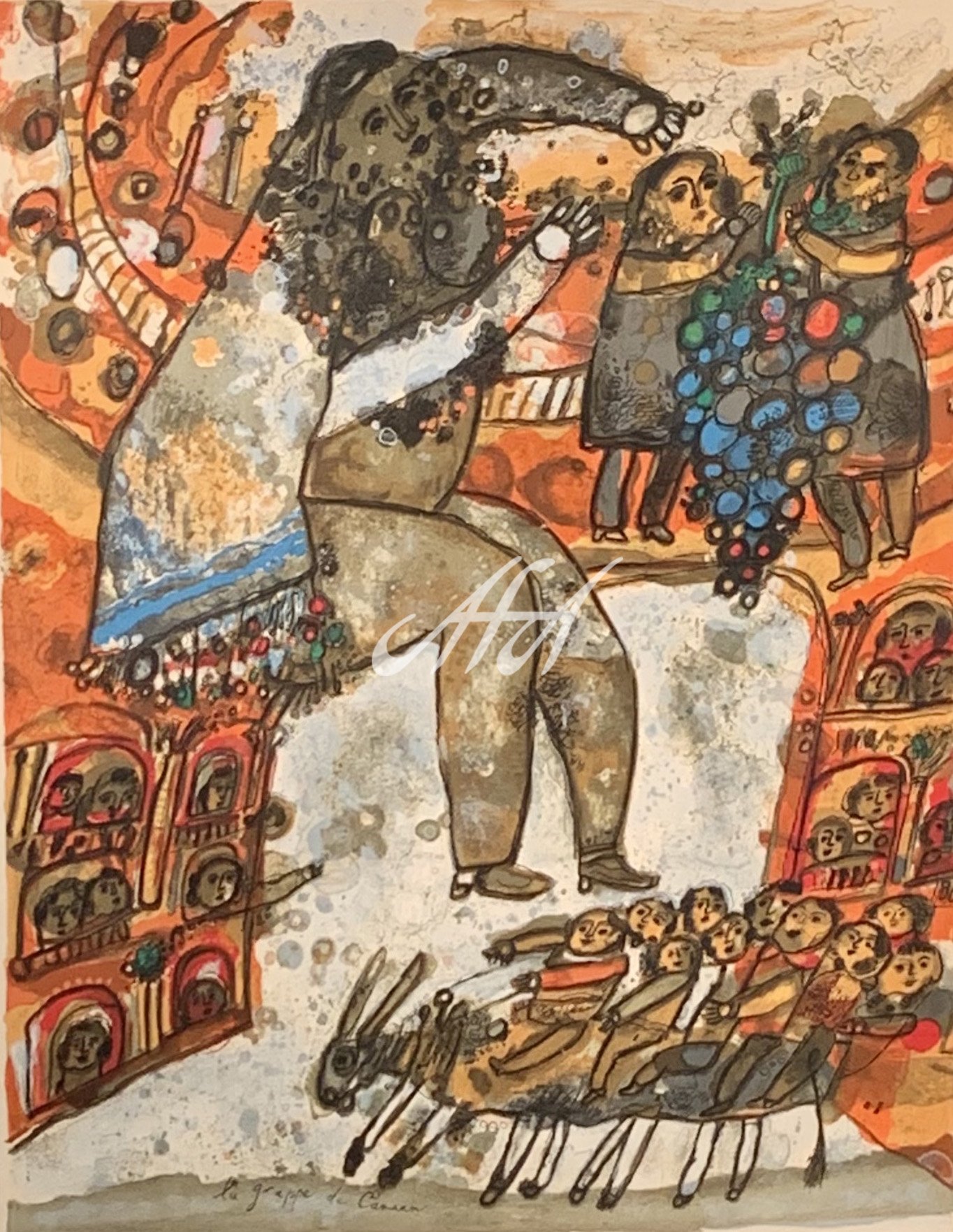Théo Tobiasse
(Israeli, 1927-2012)
“Bodies are playhouses for people’s inner lives.”
— Théo Tobiasse
Celebrated artist Théo Tobiasse was a postwar contemporary master of the Paris School. With rich colors and loose brushstrokes, his works depict symbolic iconography and people, evoking a Judeo-Christian mysticism in a similar vein to Chagall, yet undeniably unique and distinctly his own. Influenced by Surrealism, Expressionism, and modern Primitivism, the artist quickly became the most popular of the up-and-coming Jewish painters after WWII when he began painting in 1960. He connected folk stories and Biblical stories to Jewish contemporary life. As he said, “For me, it is the same when people exit from Russia to America or from Egypt to Canaan.” Elements of his own past, his dreams, mythology, Judaic, and biblical legends, and themes of exile mingle in his images of revered folklore, erotic fantasies of Woman as a lover, or of Woman as mother, and of cities, like Paris, Venice, New York, and Jerusalem. Exile was a pivotal force in his own life as his family had been forced into hiding during the war while he was a teenager. The experience was deeply impactful, shaping the rest of his artistic future. As a defining part of his past, and linked to his faith, exile became a growing theme in his work, visible in the imagery, for example, a candelabra representing the glow of hope, in titles, and in words used visually. As author Chaim Potok observed in his book, Theo Tobiasse: Artist in Exile, “One cannot escape the feeling that he uses colors and words to conquer the evils he has experienced in the flesh, hence, the lively primitivism… and the stately themes of the tribe.”
His style is a fusion of techniques that compound into a full-bodied, poetic magma that exalts the senses. An earthy and rainbowed palette glimmers through sensual textures, authentic and imaginative drawing, and often meaningful concepts. Words were magic to him and he included them in his images - to prolong the experience, as opposed to explain it. Some of his works contain words that he wrote, then painted over, or some a Hebrew symbol he pasted on and then covered with paint or ink. If one holds the work to the light, they might see hints of the message. A richness pervades his work, as well as dreamlike and emotional qualities.
The artist’s parents were Lithuanian and moved from there to Palestine, at the time, now Israel, hoping to find the Promised Land, which is where Théo was born in 1927, just after they arrived. They struggled and unable to make things work, moved back to Lithuania while Theo was still very little. Subjects and symbols in his later artwork would refer to this time, like the round teapots and paunchy samovars, the lights of steamers decorated with colored flags going down the Niémen river, sleds in the snowy streets of Kovno, and the country home in the greenery of Kaletova. His father was fearful of violent riots occurring against Jewish communities at the time in Eastern Europe, so in 1931, they moved again, with five-year-old Theo, traveling through Germany and Berlin, this time hoping his father would find work in Paris. Adjusting to the new culture was difficult, but Paris would forever retain an aura of nostalgia for Theo, a feeling also visible in his paintings.
In the summer of 1940, when Theo was 13, Nazi forces took over Paris, but he was able to continue his education mostly undisturbed for around two years. As a Jew he could no longer attend public schools, so he studied art at a private school. He went to Montmartre daily to sketch, a picturesque area where artists famously gathered. In July of 1942, however, that ended when the Germans began rounding up Jews and forcing them into concentration camps. With the help of a Christian concierge in their building in the 18th arrondissement, the Tobiasse family went into hiding in a small, unoccupied apartment. The Nazis did come and search for them, but came to the conclusion that the Tobiasses had fled. They lived for 25 months, from July of 1942 to August of 1944, in a tiny living space, without what most would consider the basics – making noise, stepping outside, turning on lights, or burning candles. They were nearly discovered more than once. Though the space was at most dimly lit by the light that filtered through the closed shutters, Theo spent his time drawing, reading, and playing chess with his father, which is where the chessboard imagery in his work comes from. They survived thanks to the help of their Christian neighbor and Jewish members of the French Resistance, whom they relied upon to bring them food and other necessities. The Resistance also provided them with a way to make some money; they brought them materials to produce rabbit fur slippers to sell. Theo would trace the slipper shape for his father to cut and his mother to sew into slippers. On August 25, 1944, Paris was liberated, and 17-year-old Theo stepped outside for the first time in two years.
He had amassed a large portfolio of drawings created in hiding, which made it possible for him to find employment with advertising companies. He would work for the next 15 years as a very successful commercial advertising artist, for companies including Hermes, utilizing his ability to draw realistically. He stayed in Paris until 1950, when he moved to Nice. Tobiasse was extremely mindful of needing to support himself financially, and saw commercial art as his only practical career choice, not believing he could support himself as a fine artist.
He spoke of the shift in the book, Tobiasse: Artist in Exile, to author Chaim Potok: “I never dreamed of art. One day it just happened. I cannot explain it. I had in my studio three unpainted white canvases. Maybe ten years I had them. One day I decided to paint. I don’t know why.” One of them was noticed at an exhibition of young artists at the Palais de la Mediterranee in Nice in 1960, and he won first prize, and then won the Dorothy Gould Prize in 1961. From then on collectors and art galleries continued to buy his work and by 1962, he was able to devote himself to painting full-time. He believed he could communicate his feelings more directly through the use of color and abstracted images, and moved away from the more realistic representation of his commercial career. The transition changed his life. He referred to the time before making art as his “first life,” and claimed that once he started making art he was “really free.” For the next 50 years, Tobiasse enjoyed ever-increasing recognition and popularity across the world, with solo shows in places including New York, Paris, Tel Aviv, Tokyo, and Caracas.
In 1976, he moved to St. Paul de Vence, where he would live and work for the rest of his life, although he began traveling to the United States extensively around 1980, particularly New York. He found a place in Manhattan where he could work for several months every year and worked more closely there with his friends and other artists. He no longer felt as comfortable in Europe due to tension between Russia and other countries at the time, and would say, “I’m sure I couldn’t live through a second occupation.” Among the work he created in New York, one piece contained the written phrase, “My soul is a boat looking for its promised land.”
In 1989, he was asked to decorate the Saint Saveur Chapel in Le Cannet, France, around the theme, “Celebration of Life”. He designed colorful stained-glass windows, sculptures, magnificent frescoes on the interior walls weaving together biblical themes with messages of peace, love, and harmony, and a mosaic of marble, natural stone and glass above the chapel’s exterior entrance. Tobiasse continued to create and explore his past and present until he passed on at age 85 on November 3, 2012 in Cagnes-sur-Mer, France.
Several monographs have been published on Theo Tobiasse’s work. The artist produced paintings, pastels, drawings, prints, etchings, pottery, sculpture, and stained glass. Many exhibitions and solo shows have been held throughout the world, and his work is found many international galleries and museums including the Biblioteque Nationale and Grand Palaise in Paris, Musee de l’Athenee in Geneva, Hôtel de Ville in Nancy, Galerie Chave in St. Paul, Waddington Galleries in London, Simon Wiesenthal Center in Los Angeles, International Art Fair in Basel, and Salon d’Art Francais in Tokyo, Petit-Palais in Geneval, among others. He created illustrated works for lovers of fine books, plus etchings and engravings, making his own plates and closely supervising all aspects of the printing process. Some of his sketchbooks have also been published. He enjoyed ceramics as well, producing pottery and dishes, as well as a series of small bronze sculptures. He also created monumental works such as the fountain entitled “L’Enfant Fou” for the Arenas Business Centre at Nice Airport, and stained-glass windows for various institutions in Strasbourg and Nice. With his decoration of the chapel St-Sauveur in Le Cannet, Tobiasse joined other illustrious twentieth century artists who also decorated chapels in the South of France like Picasso in Valauris, Matisse in Vence, and Jean Cocteau in Villefranche-su-Mer.
American Fine Art, Inc. is proud to feature the original works and limited editions of Théo Tobiasse. Visit our 12,000 sq. ft. showroom in Scottsdale, Arizona or call today. Our website is offered only as a limited place to browse or refresh your memory and is not a reflection of our current inventory. To learn more about collecting, pricing, value, or any other art information, please contact one of our International Art Consultants. We look forward to giving you the one on one attention you deserve when building your fine art collection. We hope you find our website helpful and look forward to seeing you in Scottsdale soon.


